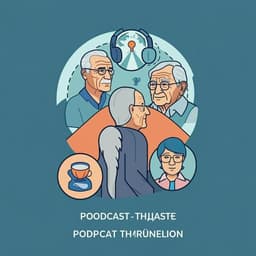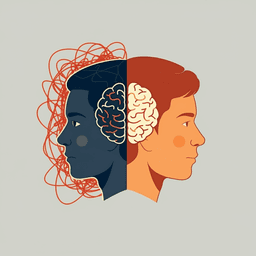
Economics
Do differences in brute luck influence preferences for redistribution in favour of the environment and health?
O. Chanel and P. Paul
This research conducted by Olivier Chanel and Pavitra Paul explores the intriguing relationship between perceived brute luck and individual preferences for redistribution in environmental and health policies. The findings reveal a self-serving bias that may reshape our understanding of public policy preferences.
~3 min • Beginner • English
Introduction
The study examines how perceived brute luck—random, non-choice-based fortune—shapes individuals’ preferences for government-led redistribution towards health versus environmental policies. Drawing on the equality of opportunity framework, which distinguishes social circumstances, effort, option luck, and brute luck, the authors position health and environment differently along public-private responsibility lines. Health is partly private (influenced by individual choices and option luck) with strong public-good elements, while the environment is largely a pure public good with limited individual responsibility for exposure. The authors hypothesize that self-serving biases will differ across domains: individuals perceiving themselves as luckier (often linked to dispositional optimism and perceived control) may oppose redistribution in health (where personal responsibility can be invoked) but not in the environment (where self-serving motives are weaker). Using three French survey waves (2000, 2006, 2008), the study aims to identify whether perceived brute luck is associated with support for redistribution in these two domains and whether observed patterns align with fairness views or reflect self-interest.
Literature Review
The paper situates its inquiry within debates on redistributive justice and the fairness cut-off between factors for which individuals are responsible versus those due to luck. Competing fairness views range from libertarian (no compensation) to egalitarian (compensate for all inequalities), with intermediate positions compensating for circumstances only, circumstances plus brute luck, or all but effort (Dworkin, Fleurbaey, Lefranc et al.). Prior experimental and survey literature shows that self-interest and self-serving biases often shape expressed fairness preferences and redistribution choices (Dana et al., Cappelen et al., Durante et al., Williams). Research on risk-taking (option luck) and fairness also indicates that judgments depend on the type of luck involved and outcomes realized (Cappelen et al., Tinghög et al.). For environmental behavior, conflicts between short-term self-interest and long-term collective interest are documented (Biel & Thøgersen; Lorenzoni et al.), and social class differences in support for redistribution are noted (Bai et al.). This study contributes by linking perceived brute luck to domain-specific redistribution preferences in a hybrid survey setting.
Methodology
Data: Three cross-sectional surveys (2000, 2006, 2008) were conducted in the Bouches-du-Rhône (France), in the PACA Regional Council assembly hall (Marseille). Sessions (~1 hour) used a hybrid design: self-administered questionnaires with interactive WTP-style elicitation via electronic voting machines, ensuring respondent attention, anonymity, minimal interviewer bias, and the use of visual aids. Sample sizes: N=264 (2000), 615 (2006), 432 (2008). Descriptive characteristics include age distribution, gender, employment, education, equivalent household income (OECD square-root scale), living in a couple, presence of minors, homeownership, and perceived presence of luck in daily life (lower/equal/higher than population average).
Measures: Two ordinal dependent variables captured desired government redistribution: (1) Redis_Env (environment) and (2) Redis_Health (health), each categorized by ranked support: strong (Rank #1), moderate (#2), weak (#3), minimal (#4 and higher). The key explanatory variable was perceived brute luck in daily life (lower/equal/higher than population average). Controls included age, gender, employment status, education, equivalent household income, couple status, presence of minors, and homeownership, plus survey wave indicators.
Models: The authors estimated three model types: Multinomial Logit (ML), Ordered Logit (OL), and Generalised Ordered Logit/Partial Proportional Odds (GOL/PPO). The GOL relaxes the OL parallel-lines assumption, allowing some coefficients to vary across cumulative logits while preserving the ordinal nature. Model specification:
- Cumulative logits for j=1,...,M-1 (M=4 categories) with P(Y_i ≤ j) = F(X_i β_j), where some β_j are constrained equal across j unless Brant tests (5% level) indicate violation of proportional odds. An iterative fitting procedure (Schneider et al.) was used to selectively relax constraints (Williams’ gologit2 in Stata).
Model selection and estimation: Starting from full models, variables were removed stepwise by decreasing p-values to obtain parsimonious models (significance in full models was preserved). Goodness-of-fit was assessed via likelihood ratio (LR) tests and AIC, comparing GOL to ML and OL. Marginal effects were computed by predicting category probabilities for observed X, altering one covariate at a time, and averaging the change; standard errors used the delta method. The primary focus was on marginal effects of perceived brute luck on each response category.
Key Findings
- Descriptive support patterns: Across waves, respondents exhibited greater support for redistribution in health than in the environment. For example, strong support (Rank #1) for environment was 13.1% (2000), 15.2% (2006), 11.0% (2008) versus health at 15.8% (2000), 20.5% (2006), 24.1% (2008).
- Model fit: GOL models were preferred over OL (LR tests p<0.0128) and not inferior to ML (p>0.318), justifying partial proportional odds. The parallel-lines assumption was rejected for some predictors (environment: 2/9; health: 1/5).
- Environment (Redis_Env): Higher perceived brute luck (vs lower) was associated with greater support for redistribution. Marginal effects: +9.7 percentage points for moderate redistribution and −15.6 pp for minimal redistribution. Living in a couple and homeownership were associated with more support (e.g., living in a couple: −8.4 pp minimal; +3.9 pp strong). Having at least one minor was associated with less support (e.g., +7.9 pp minimal; −3.7 pp strong). Higher household income predicted lower support for environmental redistribution. Male gender showed some positive association with higher redistribution levels at certain thresholds. A positive survey wave effect was observed in 2006 for environmental redistribution.
- Health (Redis_Health): Higher perceived brute luck (vs lower) was associated with lower support for redistribution in health. Marginal effects: +8.9 pp for minimal redistribution; −5.4 pp strong; −3.3 pp moderate. Employed females were more supportive (−5.5 pp minimal; +3.7 pp strong). Positive survey wave effects were observed in 2006 and 2008 for health redistribution.
- Interpretation: Perceived luck has opposite directional effects across domains: those perceiving themselves luckier favor environmental redistribution but oppose health redistribution, consistent with self-serving bias in health (where personal responsibility can be invoked) and fairness-aligned preferences in environment (a purer public good).
Discussion
The findings indicate that a GOL approach best captures the ordinal nature of redistribution preferences while accommodating non-parallel effects of covariates. Crucially, perceived brute luck exerts opposite influences across domains: greater perceived luck increases support for environmental redistribution but decreases support for health redistribution. This pattern aligns with the notion that self-serving biases are more salient in health, where behaviors and option luck arguably influence outcomes, whereas environmental exposure is less individually controllable, bringing fairness views to the fore. Socio-demographic correlates further differentiate domains: higher incomes align with reduced support for environmental redistribution, potentially reflecting lesser exposure to externalities and greater capacity to avoid them, while couple status and homeownership align with stronger environmental redistribution support. The results also resonate with psychological frameworks (e.g., Maslow’s hierarchy), as health relates to subsistence needs and may be prioritized differently from environmental concerns. Overall, the study supports that fairness views and self-interest jointly shape redistribution preferences, with brute luck perceptions serving as a key lens to detect self-serving bias in health versus fairness-based support in the environment.
Conclusion
The study demonstrates that perceived brute luck meaningfully shapes preferences for redistribution, with opposite effects across environment and health. Higher perceived luck increases support for environmental redistribution but reduces support for health redistribution, providing empirical evidence of self-serving bias in health and fairness-aligned preferences in the environment. Methodologically, partial proportional odds models offer an effective framework for analyzing ordinal redistribution preferences while relaxing proportionality when warranted. Policy-wise, assuming inequalities arising from luck are unjust, the findings support equalization policies in health. Future research should investigate redistribution preferences in additional domains (education, unemployment and social action, aid to poor countries, etc.) and disentangle mechanisms behind the observed domain differences (fairness views versus self-serving bias), potentially via targeted laboratory experiments.
Limitations
- Cross-sectional survey waves (2000, 2006, 2008) with different respondents prevent tracking individual dynamics and may capture pooling effects rather than within-person changes.
- The mechanisms behind opposite effects of brute luck on health versus environment cannot be disentangled with the available data; distinguishing intrinsic fairness views from self-serving bias would require controlled experimental designs.
- Some unobserved determinants of health-related preferences (current health status, risk behaviors, preventive efforts) were not directly measured.
- While non-parallel lines can pose modeling challenges, no problematic predictions arose in these estimates; nonetheless, partial proportional odds models entail complexity in interpretation.
Related Publications
Explore these studies to deepen your understanding of the subject.







